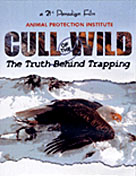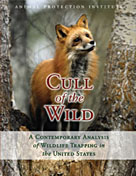Cull of The Wild: The Truth Behind Trapping

The Animal Protection Institute (API) is proud to introduce our award-winning video CULL OF THE WILD: The Truth Behind Trapping. Featuring new and archival footage and exclusive interviews with trappers, biologists, veterinarians, several members of Congress, and wildlife advocates, CULL OF THE WILD: The Truth Behind Trapping exposes the inherent cruelty of trapping and refutes the myths perpetuated by trapping proponents.
Trapping is a relic from a less enlightened time when fur was the height of fashion and the lone trapper was an icon of the American West. The reality is indescribable and indiscriminate animal suffering. CULL OF THE WILD: The Truth Behind Trapping makes the case that trapping -- whether for profit, recreation, or wildlife management -- is unjustified in the 21st century. CULL OF THE WILD: The Truth Behind Trapping leaves the viewer with renewed hope that this barbaric practice can be stopped through grassroots activism, increased public education, and changes in public policy.
CULL OF THE WILD: The Truth Behind Trapping was produced by 21st Paradigm, a non-profit film corporation that produces progressive media specific to environmental and animal welfare issues. Bullfrog Films, the country's oldest and largest publisher of environmental videos and films, has selected CULL OF THE WILD for distribution to exclusive markets. It is also available for activists, individuals, non-profit organizations, and the media from the Animal Protection Institute (API).
Cast/Crew:
- Producer: Camilla Fox
- Director/Editor: Vanessa Schulz
- Assistants: Christopher and Donna Simms
- Narrator: Jim Cissell
Excerpts From The Video
"As a veterinarian, I look at the trap as an abominable device that just cannot be allowed to be used because it is unconscionably cruel."
"The trapper will come back to the [trap] and find that there's a leg there, that the animal's chewed it off, broken it off, twisted it off. In some cases the animal's still alive in the trap, and another predator's come along and killed it."
"If the habitat is there and the resources are there, the species is going to try to fill that niche; so if you remove a few animals, whether it's trapping or whatever, the natural tendency of that species is to just reproduce more ... so it's really a never-ending game."
"One of the big problems with traps despite claims to the contrary is that by their very nature [they] are non-selective in what they catch, and I think this is evidenced by the fact that we see eagles and owls and hawks of various types that are caught in traps, and we only see those that people bring to us so we believe that's probably the tip of the iceberg."
"The leghold trap is inherently non-selective; it is probably the most cruel device ever invented by man, and is a direct cause of inexcusable destruction and waste of our wildlife. My trapping records show that for each targeted animal trapped, two unwanted individuals were caught; because of trap injuries, these non-target species usually had to be destroyed."
"We spend about 10 to 15 million dollars a year in so-called 'predator control.' They kill indiscriminately animals that don't even kill sheep [livestock]. The bottom line is -- it would cost less money if we paid each rancher for his lost sheep [livestock]."


